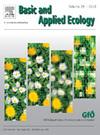Bacterial community structure in bulk soil and rhizosphere of alpine plants exhibits opposite longitudinal patterns
IF 3.5
2区 环境科学与生态学
Q2 ECOLOGY
引用次数: 0
Abstract
Soil bacteria play a key role in determining vegetation dynamics and ecosystem functions in natural grasslands, and can change along biogeographic gradients due to the sensitivity to abiotic and biotic factors. However, it remains unclear whether there are differences in longitudinal patterns and main drivers of bacterial community structure between bulk soil and rhizosphere, especially in alpine grassland ecosystems. In this study, we characterized bacterial communities in rhizosphere of alpine plants (28 species) and bulk soil at 13 sites of three alpine grassland types along the longitudinal gradient (from 82.5°E to 93.8°E) in China. Our results showed that climate and soil properties (e.g. mean annual precipitation, soil pH, and organic matter content), as well as bacterial taxonomic diversity in these two soil origins, changed along the longitudinal gradient. Total OTUs richness, Shannon index, and generalist richness of bacterial communities in the bulk soil increased along longitude, apparently due to the higher organic matter content and lower available potassium content. On the contrary, Shannon index in the rhizosphere decreased along longitude and was not related with any environmental factor. The dissimilarity in bacterial communities between paired samples was positively related with the differences in longitude and environmental factors (mean annual precipitation and soil pH in particular) for the two soil origins. There was a positive relationship between bacterial community dissimilarity among rhizosphere samples and the phylogenetic distance of co-occurring plant species in the individual sites of different alpine grassland types, suggesting phylogenetic conversation in plant-bacteria interactions under field conditions. Our findings suggest that the differential responses of bacterial communities in the rhizosphere versus bulk soil to abiotic and biotic factors may underlie their opposite longitudinal patterns, which highlights the necessity of integrating biogeographic and phylogenetic approaches in exploring plant-soil bacterial associations.
高山植物根际和块状土壤细菌群落结构呈现相反的纵向格局
土壤细菌在天然草地植被动态和生态系统功能中起着关键作用,由于对非生物因子和生物因子的敏感性,土壤细菌可以沿生物地理梯度变化。然而,目前尚不清楚块状土壤和根际土壤细菌群落结构的纵向格局和主要驱动因素是否存在差异,特别是在高寒草地生态系统中。在纵向梯度(82.5°E ~ 93.8°E)范围内,对中国3种高寒草地类型的13个样地的28种高寒植物根际细菌群落进行了研究。结果表明,两个土壤源区的气候、土壤性质(如年平均降水量、土壤pH值和有机质含量)以及细菌分类多样性沿纵向梯度变化。块状土壤中总OTUs丰富度、Shannon指数和细菌群落的总体丰富度沿经度呈增加趋势,这可能是由于有机质含量较高而速效钾含量较低所致。相反,根际香农指数沿经度呈下降趋势,与环境因子无关。配对样品间细菌群落的差异与经度和环境因子(特别是年平均降水量和土壤pH值)的差异呈正相关。不同高寒草地类型根际样品间细菌群落差异与共生植物物种的系统发育距离呈正相关,表明在野外条件下植物-细菌相互作用中存在系统发育对话。我们的研究结果表明,根际和块状土壤中细菌群落对非生物和生物因素的不同响应可能是其相反纵向模式的基础,这突出了在探索植物-土壤细菌关联时整合生物地理学和系统发育方法的必要性。
本文章由计算机程序翻译,如有差异,请以英文原文为准。
求助全文
约1分钟内获得全文
求助全文
来源期刊

Basic and Applied Ecology
环境科学-生态学
CiteScore
6.90
自引率
5.30%
发文量
103
审稿时长
10.6 weeks
期刊介绍:
Basic and Applied Ecology provides a forum in which significant advances and ideas can be rapidly communicated to a wide audience. Basic and Applied Ecology publishes original contributions, perspectives and reviews from all areas of basic and applied ecology. Ecologists from all countries are invited to publish ecological research of international interest in its pages. There is no bias with regard to taxon or geographical area.
 求助内容:
求助内容: 应助结果提醒方式:
应助结果提醒方式:


